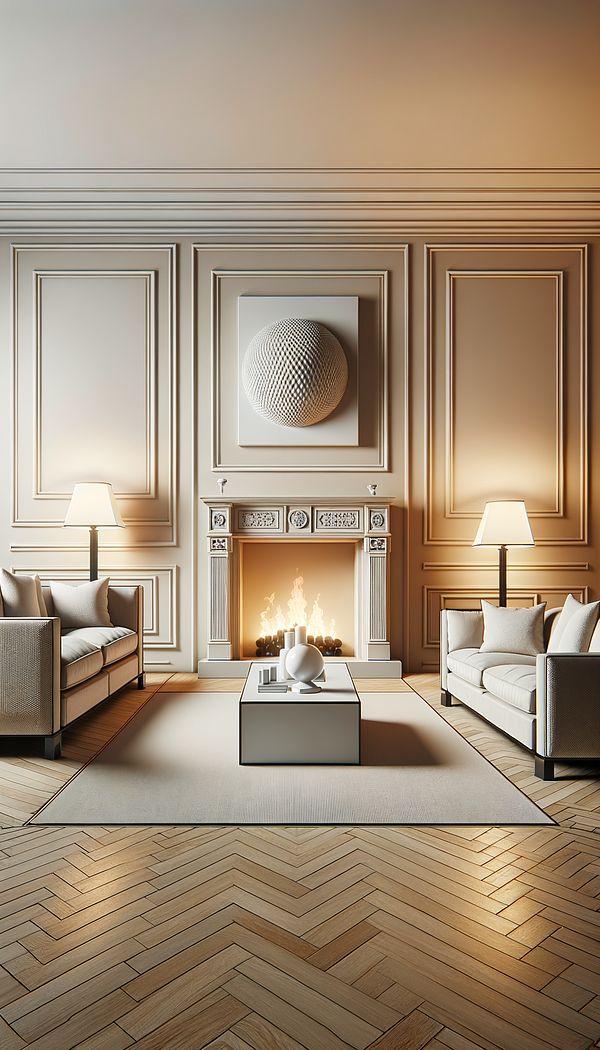What is Symmetry?
Symmetry in interior design refers to a balanced distribution of visual weight on either side of a central axis.
Description
Symmetry is a fundamental concept in interior design that helps create harmonious and well-balanced spaces. It involves arranging elements within a space so that they are mirrored on either side of a central axis, creating a sense of order and stability. This can be achieved through the placement of furniture, artwork, and other decorative items, ensuring that each side of the room mirrors the other in terms of visual weight and attraction.
While symmetry is often associated with more traditional or classical design styles, it can be applied in any setting to bring about a sense of calm and refinement. Designers might choose symmetry to emphasize particular architectural features, create a focal point, or simply to establish a space that feels meticulously organized and cohesive. Despite its structured nature, symmetry can be softened with the addition of contrasting textures, colors, and patterns to prevent spaces from feeling too rigid or monotonous.
One of the beauties of symmetry is its adaptability; it can be strict and formal, with identical objects and arrangements on either side of the axis, or more relaxed and implied, where the general shape or theme is mirrored without exact replication. This flexibility allows designers to tailor the degree of symmetry to suit the client's personal style and the overall aesthetic of the space.
Usage
Symmetry is used in various spaces, from grand entryways where matching console tables or ornate mirrors might flank a central doorway, to cozy living rooms where a sofa is centered between two identical side tables, each holding matching lamps. In dining areas, symmetry can be achieved through the even placement of chairs around a central table, or by hanging a chandelier directly above the center of the table to act as a visual anchor.
FAQs
-
Can symmetry still be achieved in rooms with irregular shapes or architectural features?
Yes, symmetry can be adapted to rooms with irregular shapes or unique architectural features by finding creative ways to balance visual weight across the space. This might involve strategically placing furniture or art to counterbalance an off-center window or using symmetrical decor in asymmetrically shaped areas.
-
Is symmetry only suitable for formal spaces?
No, while symmetry is often associated with formality, it can be adjusted to suit any style, including casual or eclectic spaces. The key is to adapt the level of symmetry and the items used to mirror each other to match the desired atmosphere of the room.
-
How can designers maintain interest in symmetrically designed spaces?
Designers can use a variety of techniques to maintain interest in symmetrically designed spaces, including introducing contrasting textures, bold color accents, and dynamic patterns. Additionally, incorporating unique or statement pieces can add a focal point and break the potential monotony of a symmetric design.
Practical Application
When applying symmetry in interior design, start by identifying the central axis of the space and plan the layout around this line. Use pairs of furniture and decor to create mirror images on either side of the axis. Remember that symmetry can be balanced with asymmetry in details, allowing for flexibility and personal expression while maintaining a cohesive overall aesthetic. Adjust the strictness of the symmetry to suit the style and function of the room.
-
Furniture Types599 articles
-
Lighting111 articles
-
Wall Treatments & Finishes157 articles
-
Space Planning & Layout134 articles
-
Decorating Principles & Elements330 articles
-
PatternPattern refers to the repeating of a decorative design.
-
Top Grain LeatherTop Grain Leather is a high-quality leather known for its durability and smooth texture.
-
DraggingDragging is a decorative painting technique used to create a striated effect on walls or furniture.
-
Cottage FurnitureCottage furniture refers to a range of casual, homey, and often vintage-inspired furniture styles that evoke the cozy, comfortable ambiance of a countryside cottage.
-
Built-inBuilt-in refers to any feature or piece of furniture that is permanently integrated into a room's structure.
